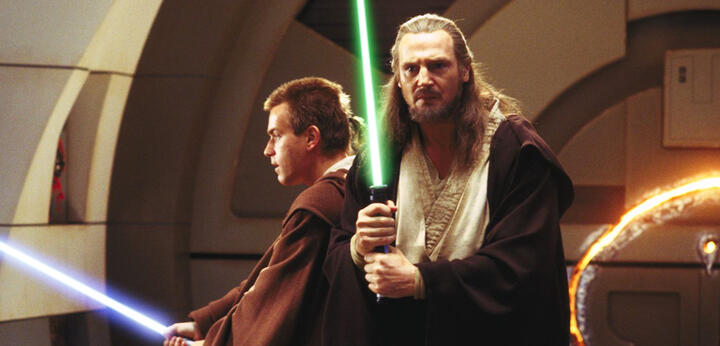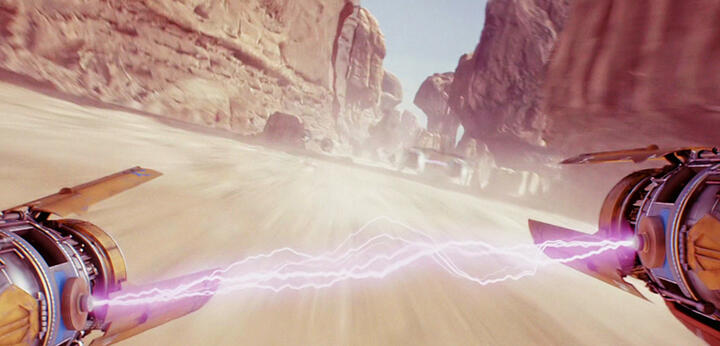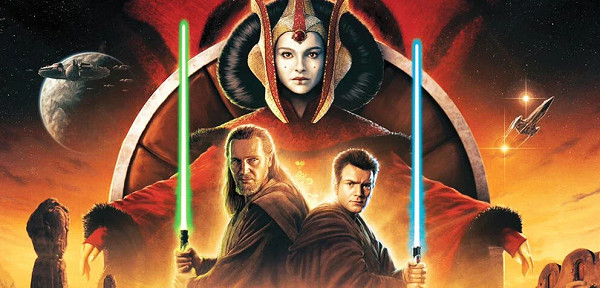With Star Wars: Episode I, George Lucas laid one of the foundations for the greatest cinematic revolution of the 21st century and turned the whole of Hollywood upside down in just a few seconds.
Even before the young Anakin Skywalker climbs into his podracer and risks his life in the dangerous Boonta Eve race in the canyons of Tatooine, the spark of rebellion is ignited in Star Wars: Episode I – The Phantom Menace. Not the rebellion that later turns against the Empire, but the rebellion that erupts from the galaxy far, far away and changes the movie world forever.
With the start of the prequel trilogy, Star Wars creator George Lucas once again asserted himself as a visionary, pioneer and rebel who challenged Hollywood’s conventional way of filmmaking with a bold idea: what if I shot a blockbuster entirely with digital cameras instead of using traditional film material? At the end of the 1990s, this was unthinkable.
Of all things, the most controversial scene in Episode I marked the beginning of Lucas’ digital image era. Although he was not the first filmmaker to bring digital images to the screen, he significantly accelerated the change in the blockbuster sector. To mark the 25th anniversary of Episode I, we take a look back at Lucas’ digital ambitions and how they influenced cinema.
Starting with Episode I: George Lucas wanted to change cinema forever with the Star Wars prequels
It was clear from the start: Lucas was not only interested in expanding his star saga with the prequels. He wanted to open the next chapter of digital filmmaking, which at the time was still unheard of in Hollywood. Digitally shot films had already been made before – Windhorse (1998) and the early Dogma 95 films from Denmark are considered key works. But for a 115 million US dollar production like Episode I, the technology was out of the question.

(Star Wars: Episode I The Phantom Menace)
Since the mid-1990s, more and more parts of film production have been adapting digital systems. However, filming itself was still anchored in analog processes in blockbuster cinema. While editing, sound and visual effects could be processed on the computer, film reels were inserted into cameras and negatives were developed. There was no trace of a competitive digital camera at the time.
Lucas and his team around cameraman David Tattersall and producer Rick McCallum also had to realize this. The ambition to shoot the prequels completely digitally was initially met with defeat. In June 1997, when the first take for The Phantom Menace was shot, the crew did not have a digital camera system that could cope with the demands of a blockbuster production
From technical problems to practical handling: digital cameras could not yet record the usual 24 frames per second, but operated at 30 frames per second. Compared to analog cinema films, the motion sequences looked blurry and the image quality was significantly poorer. And would the cameras even survive the heat of filming in Tunisia?
Nevertheless, Lucas was not dissuaded from his vision. He had been experimenting with the possibilities of digital cameras since 1995. In collaboration with Sony and Panavision, he developed camera prototypes and new lenses that he needed for his work. Mike Blanchard, Vice President of Post-Production at Lucafilm, breaks down the specific details in an in-depth interview with StarWars.com
The first digital Star Wars images are hidden in Episode I – you’ve probably never noticed them
When Lucas returned to the studio in August 1998 for subsequent filming, he finally had a digital camera in his luggage: the Sony HDC-750. The epic lightsaber duel with Darth Maul in the finale could not be filmed with it. Instead, the camera was used for less complex scenes, such as the infamous midi-chlorian moment on Tatooine, which is still debated today.

(Star Wars: Episode I The Phantom Menace)
The night before the pod race, Qui-Gon Jinn takes a sample of Anakin’s blood to find out the midichlorian level that determines the boy’s Force sensitivity. The scene made pop culture history due to the outrage of many fans. The fact that the Force can be measured in numbers was tantamount to demystifying Star Wars. But what few people know: Film history was also made here.
Lucas filmed the scene between Qui-Gon and Anakin with both Sony’s digital camera and a classic 35 mm camera. In the end, two shots that were filmed with the digital camera ended up in the movie – a milestone. Further tests with the HDC-750 were carried out on the Coruscant scenes, among others. These included, for example, the scene in which Anakin says goodbye to Padmé.
But what exactly did Lucas hope to achieve with digital filming? At first glance, there were many disadvantages and hurdles, from the immature technology to skeptical views in the industry. For Lucas, digital images were the next logical step after almost all other stages of film production had gone digital, especially for an elaborate blockbuster like Star Wars.
Efficiency and control: the digital transformation made filmmaking easier for George Lucas at all levels
In order to insert computer-generated effects into his film, Lucas had to digitize the filmed material. So why not work completely digitally? For Lucas, who felt more comfortable in the editing room than on set, the digital image meant more control and a seamless transition to post-production. He was all about efficiency. Last but not least, he financed the prequels himself with his production company Lucasfilm.

(Star Wars: Episode I The Phantom Menace)
In an interview with the American Film Institue in 2009, Lucas explained his reasons for shooting digitally:
The process is much more valuable. It’s much easier to handle, so much less restrictive. It gave me a huge advantage in the day-to-day process of making movies and saved me tons of money. I am still an independent filmmaker.
Financial issues have been with Lucas since the beginning of his filmmaking career:
‘I pay all my own bills, so I have to be careful. I don’t have the unlimited resources of the big studios and have to worry about where the money will come from for my next movie if the one I’m working on either goes over budget or doesn’t do as well as I’d hoped. That’s always a factor. We try to shoot it in the most cost-effective way, and that’s where digital has really made a big difference.
In his tests, Lucas wanted to find out whether the digital image could be combined with the rest of the film. The result was convincing: “It fit so well that nobody noticed.” Unfortunately, there is no complete list of which shots in Episode I came from digital cameras. Paul Duncan, the author of the Star Wars Archives, only verified the midichlorian moment in his research
Lucas’ unwavering digital ambitions: Hollywood hadn’t seen this since sound and color film
Although only a few digital seconds ended up in Episode I, the message behind it was clear: Lucas was serious about what he was doing. And Hollywood couldn’t ignore that message.
Lucas told the American Film Institute:
I now knew I had the camera and the objects and could shoot the next movie completely digitally and not have to jump back and forth between the medium.

(Star Wars: Episode I The Phantom Menace)
After this success, Lucas immediately initiated the next step in cinema digitization: Episode I was the first blockbuster to be shown with digital copies, specifically in two cinemas in Los Angeles and two in New York, which was an absolute novelty at the time, as the Los Angeles Times noted in a report from June 1999.
Nowadays, digital projections are a matter of course. Before the turn of the millennium, Lucas was faced with the challenge of creating moving images with digital tools – as well as the locations where they would be performed. In 1977, with Star Wars, he placed great importance on ensuring that Dolby sound could be reproduced appropriately in cinemas. With the prequels, it was the projectors.
From the digital production pipeline to the digital distribution system: Episode I’s attempts at a major retooling in the cinema industry were not enough, but the message behind it remained unmistakable. If the future of Star Wars was digital, it could only be a matter of time before other filmmakers followed suit
Three years after Episode I, George Lucas made good on his digital cinema promise with Attack of the Clones
When Star Wars: Episode II – Attack of the Clones hit the big screen in 2002 as the first Hollywood blockbuster to be shot entirely digitally, the digital rebellion had already become an entire revolution. The Feast (1998) gave the Dogma 95 movement a rough digital edge, while Nouvelle Vague legend Agnès Varda made her digital debut with The Collector and the Collectress (2002).

(Star Wars: Episode II Attack of the Clones)
Aleksandr Sokurov was able to shoot the 96-minute Russian Ark (2002) in one take thanks to digital cameras, while Danny Boyle got lost in the digital image noise of the zombie apocalypse in 28 Days Later (2002). Whether established Hollywood great (Robert Altman with The Company, 2003) or screen rebel (Robert Rodriguez with Spy Kids 2, 2002): In the end, Michael Mann outran everyone with his digital frontier experiences Collateral (2004), Miami Vice (2006) and Public Enemies (2009).
Digital cinema was unstoppable.
25 years after Episode I, digitally shot films and digital projections have become the new standard. Without Lucas’ groundwork at blockbuster level, this rapid development would have been inconceivable. An industry that is over 100 years old has been completely transformed within a decade. In 2013, digitally shot films represented the majority in commercial cinema for the first time. Today, it is over 90 percent.
It is all the more ironic that the revival of Star Wars in cinema has turned its back on Lucas’ greatest legacy. Star Wars: The Force Awakens (2015) was the first Star Wars movie since Episode I to return to film. Director J.J. Abrams and cinematographer Dan Mindel opted for 35mm and 65mm film. Star Wars should look like it did in the 70s and not like the cinema of the future.
Star Wars has turned its back on George Lucas’ digital legacy, but it’s all over the movie theater
Has the digital image with its zeros and ones demystified (cinema) magic just like the midichlorians? Digital and analog have often been played off against each other in recent years. Vivid images with rich texture vs. flat, soulless shots. It’s not quite that simple. More and more films are blurring the boundaries and showing just how diverse digital cinema can be.

(Star Wars: Episode I The Phantom Menace)
When we look at the Oscar-nominated The Holdovers, we see a movie that uses digital tools to emulate the grainy film look and looks like it was just found in a forgotten film canister. Contrast that with a sci-fi blockbuster like Avatar: The Way of Water, which reveals never-before-seen 3D visual worlds with incredible color and movement.
Read on to find out more: How George Lucas is saving movie history today
It is impressive testimony to the fact that one of cinema’s most powerful tools was created here – thanks in part to Lucas’ pioneering work on the Star Wars prequels. Digital cameras and all the film technologies associated with them can produce all kinds of images. As with all filmmaking tools, the crucial question is how they are used.

